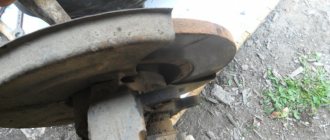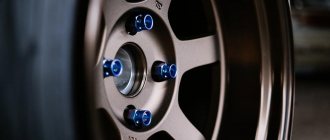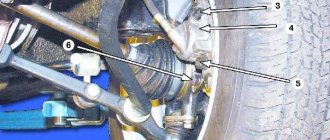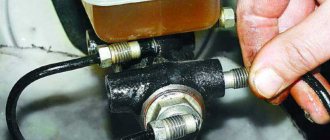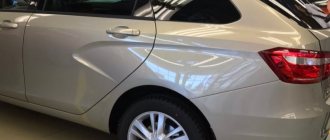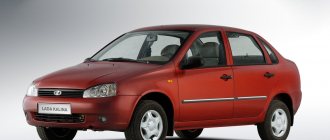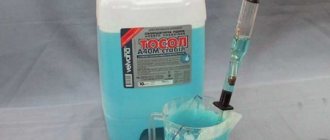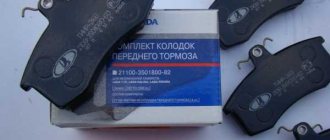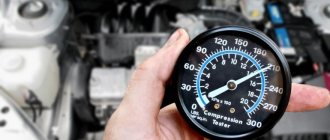The braking system is designed to capture kinetic energy and transfer it into thermal energy. This thermal energy is created by the driver when he presses the brake pedal. The driver's foot force is increased and then converted into hydraulic pressure, which causes the piston to move inside the caliper. The movement of the piston causes the brake pads to contact the rotating rotor (brake rotor).
The friction between the brake pads and the brake rotor generates heat, which is then dissipated by convection (that is, hot air rising from the surface of the disc rotor) into the atmosphere. Over time, the thickness of the brake disc decreases as the column gradually wears away the metal from its surface. In this article we will tell you everything about the minimum thickness of the brake disc.
Design features
The bulk of the front and rear discs are made of cast iron. Its popularity was facilitated by its low cost and good friction properties. But the trouble is that during the braking process this material heats up. This can lead to warping, changing the shape of the working surface and ultimately uneven erasing. To minimize these phenomena, manufacturers began producing front and rear discs with internal ventilation. They also began to cut grooves on their surface and perforate this product. This made it possible to significantly reduce overheating and increase their operating time.
Effective adhesion between the pads and the disc begins only after they are ground in. At this time, you should not press the brake sharply, but stop smoothly. This usually happens with a mileage of no more than 1000 km. You can check the effectiveness of lapping on a special stand.
Fix defects or replace?
When the measurements are completed and the exact diagnosis is clear, the car owner is faced with the question of whether to restore the old product or purchase a new one. It should be remembered that the disc can be sharpened only if there is residual thickness (from 22 millimeters). This is true for ventilated discs. Many experts recommend replacing only. However, if the price of a new disk is too high, and there is a spare thickness, you can try to restore it.
Small beads and grooves can be removed by grooving using special equipment. Some even do the grooving with a file, but this is unreliable. The essence of the operation is that a thin layer is removed from each side of the disc. Then the product receives a perfectly flat surface.
Before boring the disc, the cause that caused the deformation or beads on the surface should be resolved. Otherwise there is no point in restoration. Among the causes of uneven wear, brake pads are in first place. If they are of poor quality or installed incorrectly, they can easily damage the surface of the disk.
Factors affecting wear
Each manufacturer itself prescribes the permissible wear rate for the wheels of the car brand it produces. These parameters are calculated based on engine power, machine weight, and other things. But it is difficult to take into account the maximum mileage after which it will be necessary to change the brake discs. After all, this is influenced by factors that cannot be taken into account:
- Driving style. If there is extreme driving, in which acceleration is replaced by sharp braking, then the wear life can be significantly reduced.
- Conditions in which the vehicle is operated. If you constantly drive through puddles in slushy weather in winter, then moisture falling on a heated disc can cause its deformation and, as a rule, uneven wear.
- Mechanical factors. The material used to make this brake element plays a role here, as does the quality of the pads used. Typically, discs are made of cast iron, but over time they began to be made from other materials: steel, ceramics, carbon. This greatly increased their service life.
- Using poor quality pads can also cause uneven wear. As a result, you will have to change this element of the brakes.
Signs of malfunction
To determine exactly how long brake discs last, several factors must be taken into account. The list includes both operational and technological parameters. Manufacturers usually limit acceptable values to average mileage. Although the service life of the brake discs in this case will not always be correct.
When identifying the state of these system elements, it is necessary to monitor the behavior of the vehicle during an emergency type of braking. In certain cases, vibration is transmitted to the steering column. In such a situation, it is necessary to carry out a direct inspection of the disks, first removing the wheels one by one.
Not only inspections, but also independent measurements with a vernier caliper will help determine the approximate service life of installed brake discs. During the measurement process, it is necessary to pay attention to the resulting consequences of operation:
- deep grooves;
- scratches;
- beats;
- chips;
- sudden changes in thickness, etc.
Experienced motorists recommend taking measurements not in two or three points, but in 6-8 areas. In this way, it will be possible to form a more correct idea of the geometry of the part.
Measurements should be taken at an equal distance from the edge of the circle. It is enough to retreat 10-15 mm. The acceptable runout value is 0.01-0.02 mm. To have the most accurate results, it is important to use high-precision instruments, which include electronic calipers and micrometers, which have an error of 0.01-0.005 mm. respectively.
Important! It is unacceptable to install twin brake pads to compensate for disc wear and block the hydraulic rod from falling out, as this will lead to negative consequences and failure of the brake system.
The problem can be identified by indirect signs. The driver will feel an increase in braking distance or lengthening of the pedal stroke. Sometimes there is noise and grinding noise from the wheels after pressing the pedal.
Determination of erase thickness
To find out what the permissible maximum thickness of a disk is, you should pay attention to its end or look at the car’s manual. There are two values there - the initial and minimum thickness of these elements of the brake system. These numbers vary depending on the manufacturer of both the machine and the parts themselves.
If the disc wears down to a point where the maximum thickness does not allow effective braking, you should immediately change them. You can measure the thickness at a service station using a micrometer.
Or, by independently determining this with a caliper, in this case we measure the thickness of the front discs by clamping them with the front part of the tool.
They need to be changed when a check shows maximum wear or if the discs have different thicknesses. These values must be checked at different points of a given brake element. This is due to the fact that its abrasion occurs unevenly.
The drum-type rear disc is checked not by thickness, but by the internal distance (diameter) from one side to the other, also at several points.
Uneven wear, which causes runout, can be checked with a special device that detects fluctuations in hundredths of its values.
Identified errors: uneven wear or different thicknesses can be corrected by turning the brake discs. But a warped or cracked element definitely needs to be replaced.
Diameter
The brake power depends on the diameter of the rotor - the larger the diameter, the larger the lever, the stronger the braking.
There are several standard brake disc diameters (140mm, 160mm, 180mm and 203mm) and a few less common ones (170mm, 185mm, 200mm and 220mm). Country bikes are most often equipped with 160mm discs, sometimes 180mm are used for the front brake, and 140mm for the rear brake. In downhill and enduro you need to brake more; 180mm and 203mm discs are used. Typically, the size is indicated on the disk itself. If there is no inscription or it is not readable, you can measure the diameter with a ruler.
If you want to install a larger diameter wheel, you will need a spacer adapter. It will move the caliper away from the mounting points on the frame or fork the distance needed to accommodate the disc.
Such adapters are commercially available - each manufacturer has their own; they may differ for the front (letter F in the name) and rear (R) brakes - you need to check the compatibility and type of mount (PM or IS). Read about caliper mounting standards here and here.
Accordingly, in order to install a disk of a smaller diameter, the adapter (if any) must be removed. There are restrictions on the minimum and maximum size of the disc that can be installed - this depends on the design of the specific frame and fork. There are no adapters that would allow the installation of a smaller diameter disk. That is, if you have a disk with a diameter of 160mm installed without an adapter, you will not be able to install a 140mm one.
To avoid making a mistake when choosing a brake disc, check:
- compliance of the bushing with the fastening standard;
- diameter matching;
- when purchasing a larger diameter disk, do not forget to purchase a suitable adapter;
- Do you want to install a disk with a smaller diameter? Remove the adapter or (if you don’t have one) abandon this idea
And one more thing: brake discs and brakes from different manufacturers are compatible (take into account the size, it must match).
A short video about rotor wear:
Sprinter W901-W905. Brake system. Club of fans of minibuses and minivans
- Unanswered topics
- Active topics
- SearchMobile version
Video on the topic
1 Mark with paint the position of the wheels relative to the hub. This will allow the balanced wheel to return to its original position. Loosen the wheel bolts with the vehicle on the ground. Raise the front of the car, place it on stands and remove the wheels.
The thickness of the brake disc should be measured at its thinnest point.
2 Measure the thickness of the disc. Service stations use a special gauge or micrometer for this, since a shoulder is formed during the wear of the disk. The thickness of the disc can be measured using a regular caliper. To do this, you need to place a lining of a certain thickness (for example, two coins) on each side of the disk. Then the thickness of two coins must be subtracted from the value obtained as a result of the measurement. Attention: measurements must be taken at several points.
3 The dimensions of the brake disc are given in the Specifications. 4 If the resulting thickness is less than the minimum specified value, the brake disc must be replaced, refer to the appropriate section. 5 If the brake discs have been machined to their minimum thickness, you can reinstall the brake pad set. 6 If there are cracks or burrs, the brake discs must be replaced. 7 Reinstall the wheels so that the markings made during removal match. Pre-lubricate the centering belt of the wheel disk on the hub with a thin layer of bearing grease. Do not lubricate the wheel mounting bolts. Replace rusty bolts. Tighten the bolts. Lower the car onto the wheels and tighten the bolts crosswise to a torque of 100 N•m.
Why is diagnosis so important?
It often happens that during movement the disk bursts and falls into pieces. The reasons for this “behavior” are malfunction, excessive wear, and untimely prevention.
To carry out diagnostics you do not need to have any special skills or knowledge. All you need to do is equip yourself with a caliper and spend 10 minutes.
- Measuring: when all dimensions of the brake assembly are recorded. If the actual thickness is close to the minimum, then the disk must be replaced with a new one. Subsequent operation of the vehicle is unsafe. For each car, the minimum thickness parameter is individual;
- Visual: inspection for cracks, defects, mechanical damage, dents. Before diagnostics, first remove the wheel;
- Dynamic: when the performance of a part can be measured while driving a car.
Note to the driver. Disks, as well as shock absorbers, are installed in pairs. The use of faulty elements, mechanisms, and assemblies is unacceptable. Drivers often try to save money on purchases, which is extremely undesirable.
What affects wear?
Each manufacturer prescribes brake disc wear standards. These parameters are obtained based on engine power, vehicle weight and other factors. But it is very difficult to calculate the mileage after which you will need to change the discs. Wear is influenced by various factors that cannot be taken into account.
First of all, it's your driving style. If the car owner prefers to drive more extreme, where sharp accelerations are replaced by equally sharp braking, then the service life of the disc is significantly reduced.
Mechanical factors also affect the service life. The material from which the brake disc is made is important here, as well as the quality of the pads. Often, discs are made from cast iron and its alloys - the material wears out more often than ceramics. The use of low-quality pads (for example, with asbestos) also leads to uneven wear.
Why change brake discs
Brake discs can be replaced for various reasons. First, replacement is required if the original rotors are worn out. Almost every rotor has a minimum thickness or throw characteristics cast or stamped somewhere in the center section of the rotor. When replacing brake pads, the rotors should always be measured with a micrometer to determine their thickness. If the rotors are worn too badly and are at or below the minimum thickness (or cannot be aligned without exceeding the limit), the disc will need to be replaced (all at once is recommended).
Measuring the thickness of the brake disc (rotor)
Worn rotors are dangerous for two reasons: thin rotors cannot absorb and dissipate heat as well as new rotors, increasing the risk of the pads getting too hot and fading under prolonged or heavy braking. Additionally, thin rotors are more likely to crack and break, which can lead to brake failure.
Another condition that usually requires replacement of this part is when the rotors are "warped" and cause vibration or pulsation when using the brakes - called brake rotor runout . When the thickness of the disc is more than a couple of hundredths of a centimeter, it pushes the pads during braking. The force is transmitted back through the caliper pistons, brake lines and master cylinder all the way to the brake pedal, creating a vibration or pulsation that can be felt by the driver. The greater the change in rotor thickness, the greater the vibration or pulsation. This is a truly annoying condition, although not necessarily unsafe. The vehicle owner may mistake these vibrations for a problem with the anti-lock braking system.
Unevenly hewn marks on the brake disc due to its runout - the reason for replacing the disc with a new one
Uneven wear and thickness can be caused by severely overheating of the rotor (brake pad or seized caliper), rotor distortion caused by uneven torque or over-tightening of the arm nuts, or even metallurgical defects in the rotor casting itself. High spots on the rotor are often discolored with a dark bluish tint. Regrinding the rotor can restore flat, parallel surfaces, but often hard spots caused by overheating or uneven wear extend to the metal surface. Over time, this will again cause uneven wear and return of pedal pulsation or vibration. Replacing the rotors with new ones eliminates any such problems.
Symptoms of wear
Many people do not know how to determine the wear of brake discs, but it is very simple. There are several signs that it is time to change the disk.
The first indicator is vibrations, grinding noises, and extraneous sounds during the process of reducing speed. The second symptom is the car skidding due to the brake system being blocked. After the driver presses the pedal, the brakes may jam.
What should be the thickness of brake pads?
A clear sign indicating that the pads are running out of service life is the appearance of a characteristic whistle when the car is braking - every time you press the pedal you will hear an unpleasant noise, similar to glass rubbing against metal.
If such a symptom appears, it is recommended to diagnose the brake system as soon as possible - remember, operating a car with faulty brakes negatively affects the safety of the driver and passengers.
| Characteristic | Wheel Bridge | Minimum thickness, mm |
| Disc diameter, mm | Front | |
| Rear | ||
| Structure thickness, mm | Front | |
| Rear | ||
| Possible runout, mm | Front | |
| Rear | ||
| Thickness of the brake lining together with the pad body, mm | Front | |
| Rear | ||
| Minimum permissible thickness of the lining together with the block body, mm | Front | |
| Rear | ||
| Minimum permissible disk thickness, mm | Front | |
| Rear |
It is also important to remember that these indicators may differ if the car has a power unit with a capacity of more than 125 horsepower or a total volume of working chambers of 2.0 liters or more. In this case, it is necessary to check the thickness level of the system components after first reading the data from the vehicle’s service book.
Note! On average, front and rear brake pads, regardless of the design of the system, wear out at different rates. This is explained by the difference in the applied dynamic force on the braking system - the front axle of the car experiences more pressure during a forced reduction in speed.
How to find out the abrasion thickness?
In order to find out the permissible maximum thickness of the brake disc, you should look at the end of the product. There are two meanings to this part. This is the original thickness, as well as the minimum allowable. The numbers may vary depending on the car and wheel manufacturer. How to determine the degree of wear of brake discs? It is enough to simply measure with a caliper and compare the numbers with acceptable standards. This is how you determine whether the product can still be used or not. The disc should also be changed if it has different thicknesses at different points.
Absolutely do not do this!
Some home-grown “Kulibins”, trying to save money on buying new brake discs, perform sometimes mind-boggling procedures in order to compensate for the minimum thickness of the brake discs.
For example, two brake pads are installed. To prevent the brake cylinder pistons from falling out. This ultimately leads to the fact that at speed the brake pads simply fly off to... nowhere. At the same time, the path of the car is known - into a ditch, and it’s good if there are no casualties.
Replacing worn brake discs at the wrong time can also lead to failure of the pistons of the working brake cylinders, CV joints, ball joints, etc. That is, by trying to save money and procrastinate, you can then lose more money. Remember the stingy...
Monitor the condition and thickness of the brake discs, and take measures to eliminate any defects noticed - there is too much at stake to neglect this.
Good luck determining the thickness of your brake rotors and replacing them.
When to change pads?
We know how to determine the permissible wear of brake discs. But it’s worth paying attention to the pads, since these elements work in pairs and together affect braking efficiency.
One of the signs of pad wear is a squeaking sound when the speed is reduced. The sound is produced by a special wear sensor. This is a special plate. When the friction layer of the pad is worn away, the plate touches the disc and causes the sensor to operate.
You can determine that the pads are worn out by the operation of the brake system. Brakes that are too weak or too harsh can indicate wear. In the first case, the braking is not intense, although the pedal is pressed quite deeply. In the second, the wheels are blocked due to the lack of friction lining.
How to determine the wear of brake discs and pads? This can be determined by vibrations during braking, as well as by visual inspection and a measuring tool. There are no other options.
Why might pad wear accelerate?
It is important to remember about difficult operating conditions, for example, driving along mountain serpentines or participating in amateur racing. In such modes, in a working brake system, the inner pad may begin to wear down many times faster than the outer one. Something similar once happened to my car. During everyday driving, the pads on the latest generation Volkswagen Jetta sedan wore evenly. This lulled my vigilance, and I stopped monitoring the condition of the internal linings. After participating in two stages of sprints (far from the most difficult for equipment), it turned out that the internal pads were almost completely worn out. This was especially noticeable on the left wheel. I was lucky that it didn’t come to the point of scuffing the brake discs!
Also, do not forget that if, for example, you drove 30,000 km and the wear of the front pads was about 50%, this does not mean that they will last up to 60,000 km. The smaller the thickness of the lining, the faster its further wear occurs. After all, the same portions of thermal energy from friction are absorbed by a less “fat” brake pad.
We determine the mileage based on the condition of the disks
Today, cars are sold by so-called resellers, who often deceive buyers. Cars come with low mileage. Many of them only look normal outwardly, but technically they are in a deplorable state. Resellers often change the pads, but simply forget about the discs. And this is in vain - the average mileage of a car can be determined by the condition of the disk.
On average, brake discs are changed every 180-200 thousand kilometers. But this is not true for all cars. Also, different drivers drive differently. Some people manage to drive 150 thousand kilometers until they are completely worn out, and some even 250. But if the mileage of a car is 70 thousand, and the total thickness of the disk is 20 millimeters, this car has probably traveled at least two hundred. It is worth refusing to purchase such a copy.
Other reasons for replacing pads
In addition to situations with critical wear, it is necessary to change brake pads in the following cases:
- the thickness of the friction material is more than 5 mm, but the lining itself has begun to peel off from the steel base;
- cracks and chips appeared on the surface, the material began to crumble;
- stains of oil or brake fluid that reduce friction properties were found on the parts;
- when the brake drum or disc is replaced.
Another reason for replacement is due to the abundance of low-quality fakes on the automotive spare parts market . New pads purchased from an unreliable retail outlet begin to squeak or squeak terribly after 1-2 thousand km, although the working part is still far from completely worn out. The culprit is the material of the part, whose hardness is comparable to metal, causing the surface to “slick” and create a creaking sound. If the elements made from unknown materials are not replaced, then the production on the brake discs will increase sharply.
Many modern cars are equipped with special sensors that detect a decrease in the thickness of the friction layer and send a signal to the driver when it reaches a critical level. This is also a reason to remove parts with worn linings and install new ones.
True, the sensors often become clogged with dirt and lose their functionality, so it wouldn’t hurt for the car owner to check the condition of the brakes himself.
